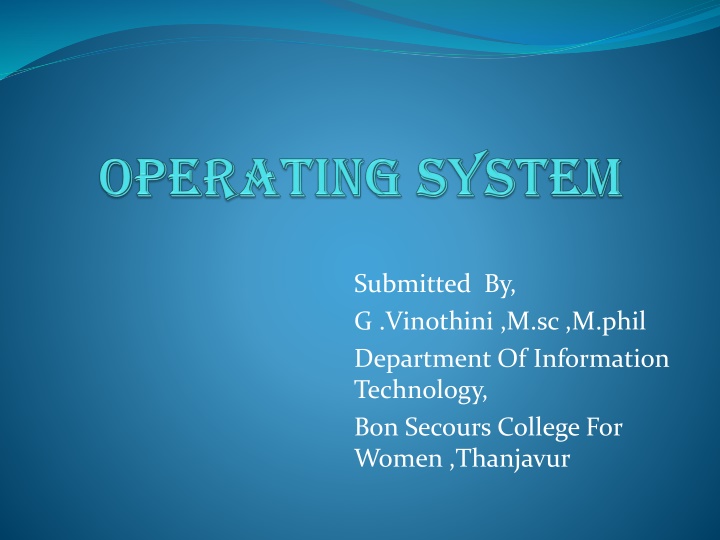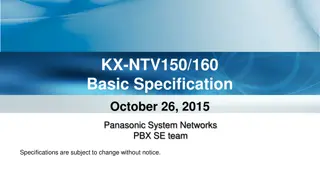
Operating Systems: A Comprehensive Overview
Explore the intricacies of operating systems, the backbone of computer functionality. Learn about its history, types, and crucial role in managing hardware and software efficiently. Delve into the functions and significance of operating system software components such as Memory Management, Processor Management, Device Management, and File Management.
Download Presentation

Please find below an Image/Link to download the presentation.
The content on the website is provided AS IS for your information and personal use only. It may not be sold, licensed, or shared on other websites without obtaining consent from the author. If you encounter any issues during the download, it is possible that the publisher has removed the file from their server.
You are allowed to download the files provided on this website for personal or commercial use, subject to the condition that they are used lawfully. All files are the property of their respective owners.
The content on the website is provided AS IS for your information and personal use only. It may not be sold, licensed, or shared on other websites without obtaining consent from the author.
E N D
Presentation Transcript
Submitted By, G .Vinothini ,M.sc ,M.phil Department Of Information Technology, Bon Secours College For Women ,Thanjavur
AGENDA: INTRODUCTION OPERATING SYSTEM HISTORY OF OPERAYTING SYSTEM OPERATING SYSTEM SOFTWARE TYPES OF OPERATING SYSTEM OBJECT ORIENTED DESIGN CONCLUSION
INTRODUCTION: To understand an operating system is to maintain the working of an entire computer system. Because, the operating system manage each and every piece of hardware and software. Operating system is a software, which makes a computer to actually work. It is the software the enables all the programs we use. OS acts as an interface between the application programs and the machine hardware.
OPERATING SYSTEM: An operating system is a software, consisting of programs and data, that runs on computer and manage the computer hardware and provides common services for efficient execution of various application software. operating system is a boss of all the computer system.
OPERATING SYSTEM: Operating system is an integrated set of program that controls the resources of a computer system and provide its users with an interface or virtual machine that is easier to use than the bare machine. A computer system consists of software (program)and hardware (physical components) in the computer . The operating system software is the chief piece of software and all of the other software. It consists of every file, every device, every section of main memory and every nanoseconds of processing time its control who can use to the system.
HISTROY OF OPERATING SYSTEM: Initially, computer were used as larger automated calculators for mathematical and statistical problems. Legitimate use can be traced back 100 years or more but there were no practical designs used by significant numbers of people until the late 1950 s. Operating systems were rudimentary , often not able to do more than read punch cards or tape and write output to machines resembling typewriters. It was a purely mechanical design and the technology of its day could not produce the wheel, gear, cogs and other mechanical parts to the high precision that he needed.
OPERATING SYSTEM SOFTWARE: Operating system software has four major types in the computer system are, Memory Management Processor Management Device Management File Management These are all the essential mangers of the operating system. A network was not always an integral part of operating system.
MEMORY MANAGEMENT: A primary responsibility of the memory manager is to protect the space in main memory occupied by the operating system itself. It cannot allow any part of it is to be accidentally or intentionally altered. RAM(Random Access Memory) is the computer main memory and it was called primary storage system. Memory management is the process of controlling and coordinating computer memory , assigning portions called blocks to various running programs to optimize overall system performance.
PROCESSOR MANAGEMENT: The processor manager is decided how to allocated the CPU. An important is to keep track of the status of each process. The processor manager monitor whether the CPU is executing a process of waiting for a read and write command to finish execution There are two levels of responsibility in process management, Job scheduler Process scheduler
DEVICE MANAGEMENT: The device management monitor every device, channels and control unit its job is to choose the most efficient way to allocate all of the system devices. Examples of the device management are printer , posts, disk, drive , e t. c Device management is the process of managing the implementation , operation and maintenance of physical and / or virtual device. It is a broad term that includes various administrative tools and processes for the maintenance and upkeep of a computing, network, mobile and / or virtual device.
FILE MANAGEMENT: The file manager keeps track of every file in the system include data file, program file, compiler and application. By using predetermined access policies , it enforces restriction on who has access to which files. The files manager also a control of what access are allowed to do with file once they access them. File management is the process of administering a system that correctly handles digital data.
TYPES OF OPERATING SYSTEM: There are the eight types of the operating system, Simple batch system Multiprogramming system Multiprocessor system Desktop system Microcomputer system Distributed system Embedded system Real time system
SIMPLE BATCH SYSTEM: Batch system data from the earliest computer when they relied on stock of punched cards or reels of magnetic tape for input. Job sticks were entered by assembling the cards into a desk and running the entire desk of cards through a cards reader as a group of batch. The efficiency of batch system is measured in throughput the number of jobs completed in a given amount of time. Examples are report general, data form, image processing.
MULTIPROGRAMMING SYSTEM: The multi program is intensive execution of multiple jobs by the same computer in multi programming system. When one program is waiting for input/output transfer there is another program ready to utilize the CPU. So it is possible for general jobs to share the time of the CPU.
MULTIPROCESSOR OS: The multiprocessor operating system refers to use of two or more CPU within a single computer system. The multiple CPU are a close communication sharing the computer bus, memory and peripheral system are referred to tightly coupled system. Multiprocessing refers to a computer system s ability to support more than one process (program)at the same time. It enables several programs to run concurrently .
DESKTOP OPERATING SYSTEM: The control program in a user machine (I . e) desktop or laptop also called client operating system. Windows is the majority of the Macintosh there are also several versions of Linux for the desktop contrast with network OS. The operating system market is slowly changing, at the moment mac OS and Linux are growing. Most people use the operating system that comes with their computer, but it s possible to upgrade or even change operating system.
MICROCOMPUTER OS: Microsoft windows and Macintosh (Mac OS) are interface This operating system can be loaded into memory from floppy disk or hard disk. This process is know as booting. Multicomputer . A computer made up of several computers. The term generally refers to an architecture in which each processors has its own memory rather than multiple processor with a shared memory.
DISTRIBUTED OPERATING SYSTEM: The distributed operating system is a software over a collection of independent network communicating and physical separate computational nodes. They handles jobs which are serviced by multiple CPU. Each individual nodes hold a specific software subset of the global aggregate operating system. The loosely coupled software allows computer and user of a distributed system to be independent each other but having a limited possibility to cooperate
EMBEDDED OPERATING SYSTEM: Embedded is specialized OS designed to perform a specific task for a device that is not a computer. En embedded OS main job is to run that allowed the device do its jobs. The embedded OS also makes the device between accessible the software that is running on the top of the OS. Some examples of embedded system are MP3 players, mobile phones, video game console, digital cameras, DVD player and GPS, household.
REAL-TIME OPERATING SYSTEM: The real-time OS is any operating system intended to serve real time application that process data as it come in typically without buffer delay. The real-time OS is a multi tasking OS for real time applications. A real-time operating system(RTOS) is an operating system(OS) that guarantees a certain capability within a specified time constraints. Examples are might be designed to ensure for a robot on an assembly line.
CONCLUSION: Conclusion without operating system the computer cannot run the application and we cannot run the application and we cannot do work in the computer .therefore operating system is very important in computer. As operating system controls and coordinates the use of the hardware among the various application programs for various uses, we can say that it plays a very important role in the computer system.

